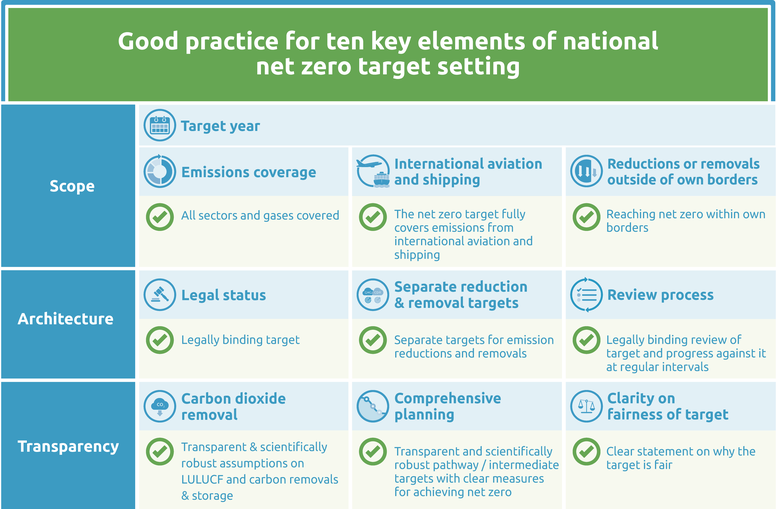Net zero targets
Summary
We evaluate the net zero target as: Acceptable.
Chile announced its net zero target for 2050 as proposed legislation in the Framework Law on Climate Change in 2020 (President of Chile, 2020) and included it in the updated NDC submitted to the UNFCCC in the same year (Government of Chile, 2020b). In November 2021, Chile included this target in the LTS and it was enshrined in law in June 2022 with the passing of the Framework Law on Climate Change (Congreso Nacional de Chile, 2022).
Chile’s net zero target covers most key elements. It covers all sectors and gases, communicates strategic goals and emissions targets per sector, and provides a detailed methodological framework. Notably, Chile underpins these sector-specific ambitions with detailed emissions pathway analyses and budgets. While Chile does not actively outline any plans to rely on reductions and removals outside its borders, future iterations of its NDC could explicitly rule out international credits.
Chile could further improve its net zero target by considering good practice standards for a few elements. It could include international aviation and shipping in its target’s scope, and explicitly elaborate on fairness considerations.
CAT analysis of net zero target
Scope
- Target year – Chile aims to reach net zero by 2050 (President of Chile, 2020).
- Emissions coverage – The target covers all GHG emissions (i.e., the 7 Kyoto gases: CO2, CH4, N2O, HFCs, PFCs, SF6, NF3) and all sectors of the economy (excluding international bunkers) (President of Chile, 2020).
- International aviation and shipping – Chile provides no information on its intention to cover international aviation and shipping.
- Reductions or removals outside of own borders – Chile does not actively outline any plans to rely on reductions or removals outside its borders. Neither Chile’s NDC nor its underlying pathways towards 2050 explicitly rule out international credits (Government of Chile, 2020a; Ministerio de Energía, 2020b).
Target architecture
- Legal status – Chile passed its net zero target in the Climate Change Framework Law (Ley Marco de Cambio Climatico, 21455) on 13 June 2022 (Congreso Nacional de Chile, 2022).
- Separate reduction & removal targets – Chile specifies separate emissions reductions and removal targets by specifying the contribution of LULUCF in 2030 and 2050. (Government of Chile, 2020b; Ministerio de Energía, 2020b).
- Review process – Chile has a legally binding process in place to review the net zero target (long-term strategy) and sectoral plans.
Transparency
- Carbon dioxide removal – Chile provides transparent pathways for carbon dioxide removal from domestic LULUCF sinks through 2050 and assumes no technical carbon removals and storage in the timeframe up to 2050 (Ministerio de Energía, 2020b).
- Comprehensive planning – Chile provides intermediate carbon budgets as well as sector specific targets in their NDC. The NDC provides several carbon neutrality scenarios per sector and highlights the necessary measures, such as reaching a 58% share of electric vehicles among private and commercial vehicles by 2050, replacing thermal power stations with renewable energy systems, and installing electric heating in public and commercial buildings. The strategy also establishes an emissions peak no later than 2025 and sets a maximum budget for cumulative emissions from 2020–2030 (Government of Chile, 2020b). The NDC further defines clear visions for 2030 and 2050 and Chile provides detailed pathway analyses (Ministerio de Energía, 2020b).
- Clarity on fairness of target – Chile makes no reference to fairness or equity in the context of its net zero target in the climate change framework law nor in the long-term strategy.
Good practice
The Climate Action Tracker has defined the following good practice for all ten key elements of net zero targets. Countries can refer to this good practice to design or enhance their net zero targets.

Further analysis
Latest publications
Stay informed
Subscribe to our newsletter






